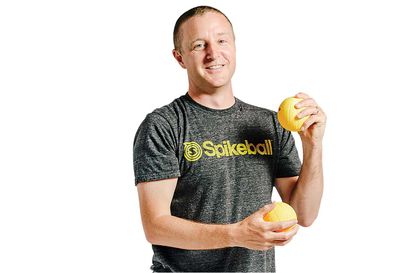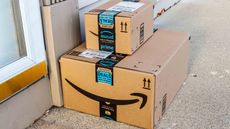Small-Business Success Story: Spikeball Inc.
This entrepreneur revived Spikeball and turned it into a multimillion-dollar business.


Kiplinger's spoke with Chris Ruder, 42, founder and CEO of the Chicago-based game company Spikeball Inc., about his path to entrepreneurship and eventually leaving corporate America to focus on his business full-time. Here's an excerpt from our interview:
What is Spikeball? It's a game played two on two with an orange-size ball and a small net in the middle -- if volleyball and four square had a baby, it would be Spikeball. A player starts a point by serving the ball down onto the net so that the ball ricochets up at the opponents, who have three hits to return the ball to the net. If they don't, their opponents score. When the ball is in play, there are no boundaries. You run, jump and dive. The first team to reach 21 points wins. The game was originally sold in the late '80s.
How did you acquire it? In 2003, my brother and I went to Hawaii with two of his friends, who brought their beat-up Spikeball set. When we played it on the beach, I loved it, and passersby asked about it. For a few years afterward, we talked about bringing Spikeball back to life. When I looked into it, I learned that the game wasn't patented and the trademark had expired. I paid about $800 for the trademark, and we eventually got a patent for design changes we made.

Sign up for Kiplinger’s Free E-Newsletters
Profit and prosper with the best of expert advice on investing, taxes, retirement, personal finance and more - straight to your e-mail.
Profit and prosper with the best of expert advice - straight to your e-mail.
How did you launch? Six of us -- family and friends -- chipped in a total of $100,000, and we found a manufacturer in China. We incorporated in 2007 and started selling in 2008. For the first five years, I kept my day job in corporate advertising sales and ran Spikeball on the side. We sold mostly on our website and a little on Amazon.com, but smaller retailers from all over the U.S. began to ask us if they could carry Spikeball. I knew nothing about retail, so I politely put them off. Finally, a shop in my wife's hometown called. I told the owners we would love to work with them if they would show me the ropes, and they obliged. We added more retailers; in 2013 we hit $1.3 million in sales, and I quit my day job.
Growth was a challenge? In early 2014, Dick's Sporting Goods called. I was floored. The norm is for you to call the 800-pound gorilla and beg for shelf space. Then REI called, then Big 5 Sporting Goods, then Modell's. Before, we had fantastic e-commerce margins, and buyers paid us within 48 hours of purchase. Now, the big guys were placing large orders and paying us wholesale prices 30 to 45 days later. We were on the verge of a cash-flow crunch, so we took a couple of short-term loans from the shareholders, then took a bank line of credit. In 2016, we had 16 employees and $13 million in sales.
You promoted the game? We identified niche communities that were well organized and met often, such as Young Life, a faith-based youth group. We sent them the product, and once it was introduced, the game traveled far on its own. We even developed a curriculum for phys ed teachers. When we saw a spark in the Ultimate Frisbee community, we poured gas on it. We hired kids to play Spikeball with free sets on the sidelines of Ultimate events. We sponsored college Ultimate teams. In 2016, we created a national ranking system, now with 2,000-plus teams.
What are you most proud of? We're profitable and haven't raised outside money. If we had, we might be at $100 million in sales today, but I would have a boss and we wouldn't be able to control our destiny.

-
 Starbucks BOGO and New Sweet and Spicy Drinks
Starbucks BOGO and New Sweet and Spicy DrinksFor a limited time, Starbucks is announcing four new "swicy" drinks that are both spicy and sweet.
By Kathryn Pomroy Published
-
 Stock Market Today: Dow Slips After Travelers' Earnings Miss
Stock Market Today: Dow Slips After Travelers' Earnings MissThe property and casualty insurer posted a bottom-line miss as catastrophe losses spiked.
By Karee Venema Published
-
 403(b) Contribution Limits for 2024
403(b) Contribution Limits for 2024retirement plans Teachers and nonprofit workers can contribute more to a 403(b) retirement plan in 2024 than they could in 2023.
By Jackie Stewart Published
-
 Roth IRA Contribution Limits for 2024
Roth IRA Contribution Limits for 2024Roth IRAs Roth IRA contribution limits have gone up for 2024. Here's what you need to know.
By Jackie Stewart Published
-
 Best Foreclosure Sites for Finding Properties
Best Foreclosure Sites for Finding PropertiesMaking Your Money Last Wondering how to find foreclosed homes for sale for your next residence or to flip for a profit? These websites will guide you to foreclosures and real estate-owned properties to buy.
By Bob Niedt Last updated
-
 Four Tips for Renting Out Your Home on Airbnb
Four Tips for Renting Out Your Home on Airbnbreal estate Here's what you should know before listing your home on Airbnb.
By Miriam Cross Published
-
 Five Ways to a Cheap Last-Minute Vacation
Five Ways to a Cheap Last-Minute VacationTravel Procrastinator? No matter. You can pull off a fun and memorable getaway on a moment's notice — without breaking the bank.
By Vaishali Varu Last updated
-
 How Much Life Insurance Do You Need?
How Much Life Insurance Do You Need?insurance Instead of relying on rules of thumb, you’re better off taking a systematic approach to figuring your life-insurance needs.
By Kimberly Lankford Published
-
 When Is Amazon Prime Day?
When Is Amazon Prime Day?Amazon Prime In 2023 Amazon had two Prime Day events — one in July and another, called Big Deal Days, in October. We expect 2024 to follow the same schedule.
By Bob Niedt Last updated
-
 How to Shop for Life Insurance in 3 Easy Steps
How to Shop for Life Insurance in 3 Easy Stepsinsurance Shopping for life insurance? You may be able to estimate how much you need online, but that's just the start of your search.
By Kaitlin Pitsker Published